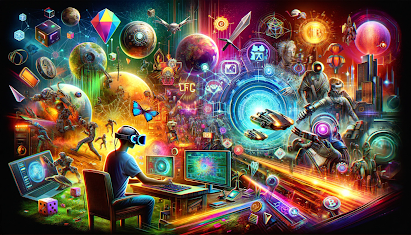The Evolution of Gaming Technology: Past, Present, and Future
The gaming industry has undergone a remarkable transformation since its inception, driven by relentless advancements in technology. From the early days of arcade games to today’s sophisticated virtual realities, the evolution of gaming technology is a story of innovation and imagination. This article explores the journey of gaming technology from its origins to the present and offers a glimpse into what the future might hold.
The Past: The Dawn of Gaming Technology
1. Early Beginnings (1970s–1980s):
The gaming revolution began in the 1970s with the introduction of arcade games like Pong and Space Invaders. These early games were simple, with basic graphics and gameplay, but they set the stage for what was to come. The 1980s saw the rise of home consoles, such as the Atari 2600 and Nintendo Entertainment System (NES). These systems brought gaming into the living room, making it more accessible to a broader audience.
2. Rise of 3D Graphics (1990s):
The 1990s marked a significant leap forward with the advent of 3D graphics. Consoles like the Sony PlayStation and Nintendo 64 showcased the power of 3D rendering, allowing for more immersive and complex gaming experiences. Games like Super Mario 64 and Final Fantasy VII demonstrated the potential of 3D environments and storytelling, setting new standards for the industry.
The Present: The Age of Innovation
1. High-Definition and Immersive Experiences:
Today’s gaming technology is characterized by high-definition graphics and immersive experiences. Modern consoles like the PlayStation 5 and Xbox Series X offer 4K resolution, ray tracing, and ultra-fast load times, providing stunning visuals and smooth gameplay. PC gaming has also seen advancements with powerful graphics cards and processors that push the boundaries of realism.
2. Virtual Reality (VR) and Augmented Reality (AR):
Virtual Reality (VR) and Augmented Reality (AR) have become significant components of contemporary gaming. VR headsets like the Oculus Rift and HTC Vive allow players to immerse themselves in virtual worlds, while AR games like Pokémon GO blend the digital and physical worlds, offering new ways to interact with games. These technologies enhance player engagement and create unique gaming experiences.
3. Cloud Gaming:
Cloud gaming is revolutionizing how games are accessed and played. Services like Google Stadia, NVIDIA GeForce Now, and Xbox Cloud Gaming (formerly Project xCloud) enable players to stream games over the internet without the need for high-end hardware. This innovation provides greater flexibility and accessibility, allowing gamers to play on various devices, including smartphones and tablets.
The Future: What Lies Ahead
The future of gaming is likely to be heavily influenced by artificial intelligence (AI) and machine learning. AI can enhance game design by creating more sophisticated non-player characters (NPCs), dynamic storylines, and adaptive difficulty levels. Machine learning algorithms could also be used to personalize gaming experiences and improve player interaction.
2. Advanced VR and AR Experiences:
As VR and AR technologies continue to evolve, future advancements may bring even more immersive and interactive experiences. We can expect improvements in headset design, haptic feedback, and motion tracking, leading to more realistic and engaging virtual worlds. Enhanced AR applications could also further integrate gaming into everyday life.
3. Blockchain and NFTs:
Blockchain technology and non-fungible tokens (NFTs) are poised to impact the gaming industry by offering new ways to manage in-game assets and transactions. Blockchain can provide secure and transparent ownership of digital items, while NFTs may allow players to buy, sell, and trade unique in-game assets, creating new economic opportunities within games.
4. Enhanced Connectivity and 5G Technology:
The rollout of 5G technology will likely revolutionize online gaming with its ultra-fast speeds and low latency. Enhanced connectivity will support more seamless multiplayer experiences, high-quality streaming, and real-time interactions, further bridging the gap between physical and digital gaming environments.
The evolution of gaming technology has been a journey of incredible innovation, transforming the way we play and experience games. From the simplicity of early arcade games to the sophisticated graphics and immersive experiences of today, gaming technology continues to advance at a rapid pace. As we look to the future, emerging technologies such as AI, VR, AR, blockchain, and 5G promise to redefine the gaming landscape, offering exciting new possibilities and experiences. The future of gaming holds endless potential, driven by creativity and technological progress, ensuring that the adventure is far from over.






Comments
Post a Comment